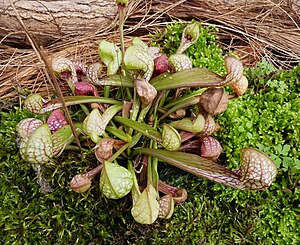Parrot pitcher plant
| Parrot pitcher plant | ||||||||||||
|---|---|---|---|---|---|---|---|---|---|---|---|---|

Parrot pitcher plant ( Sarracenia psittacina ) |
||||||||||||
| Systematics | ||||||||||||
|
||||||||||||
| Scientific name | ||||||||||||
| Sarracenia psittacina | ||||||||||||
| Michx. |
The parrot pitcher plant ( Sarracenia psittacina ) is a carnivorous plant from the family of the Pitcher plants (Sarraceniaceae). It is native to the extreme southeast of the USA and is of an unusual shape among pitcher plants.
description
The rhizome is up to 1 centimeter thick and usually grows vertically. Typical of the plant are the tubular hoses arranged in a horizontal, down-to-earth rosette, with a hollow, semicircular hood at the end. The tubes are 10 to 25, rarely up to 40 centimeters long and 1 to 4 centimeters wide. At the end facing the axis, there is a small, inwardly opened collar in the middle. The ala is 2 to 35 millimeters wide, it widens in a wave-like manner from the leaf base to the center and then narrows again towards the outer end. The tubes are - depending on the shade - differently colored, green if the shade is very strong, otherwise the foliage is reddish-green to deep red, with red veins and white, so-called areoles from the hood to the upper end of the tube. The latter allow light to penetrate into the interior and thus disorient the captured prey, to further support the catch, the inside of the tubes has a longer hair, which allows the tubes to function like fish traps .
The slightly sweet-smelling, deep red flowers appear at the end of March to May and are located on a 25 to 45 centimeter long stem. The 2 to 4 centimeters in diameter measuring flowers have 2 to 3 centimeters long, round petals , the sepals are also deep red and slightly spotted.
distribution
It is native to the southeast coast of the USA from southeast Georgia over the Florida Panhandle to the extreme southeastern Louisiana . The plant prefers temporarily flooded edges of ponds or small rivers , at times of flooding it lives semi-aquatic.
Systematics and botanical history
The species was first described in 1803 by André Michaux . The species name is derived from the Greek psittakos for "parrot" and refers to the similarity of the leaves with the beak of a parrot. Sub-taxa are missing. Morphologically, the species of the cobra lily is close to Darlingtonia californica , but whether this indicates an evolutionary relationship has not been adequately researched.
Individual evidence
- ^ A b c d Donald E. Schnell: Carnivorous Plants of the United States and Canada. 2nd edition. Timber Press, Portland OR 2002, ISBN 0-88192-540-3 , p. 212 ff.
- ^ A b c d Stewart McPherson: Pitcher Plants of the Americas. The McDonald & Woodward Publishing Company, Blacksburg VA 2007, ISBN 978-0-939923-74-8 , p. 230 ff.
Web links
- Sarracenia psittacina inthe IUCN Red List of Threatened Species 2013.2. Posted by: Schnell, D., Catling, P., Folkerts, G., Frost, C., Gardner, R. & et al. , 2000. Retrieved May 12, 2014.
